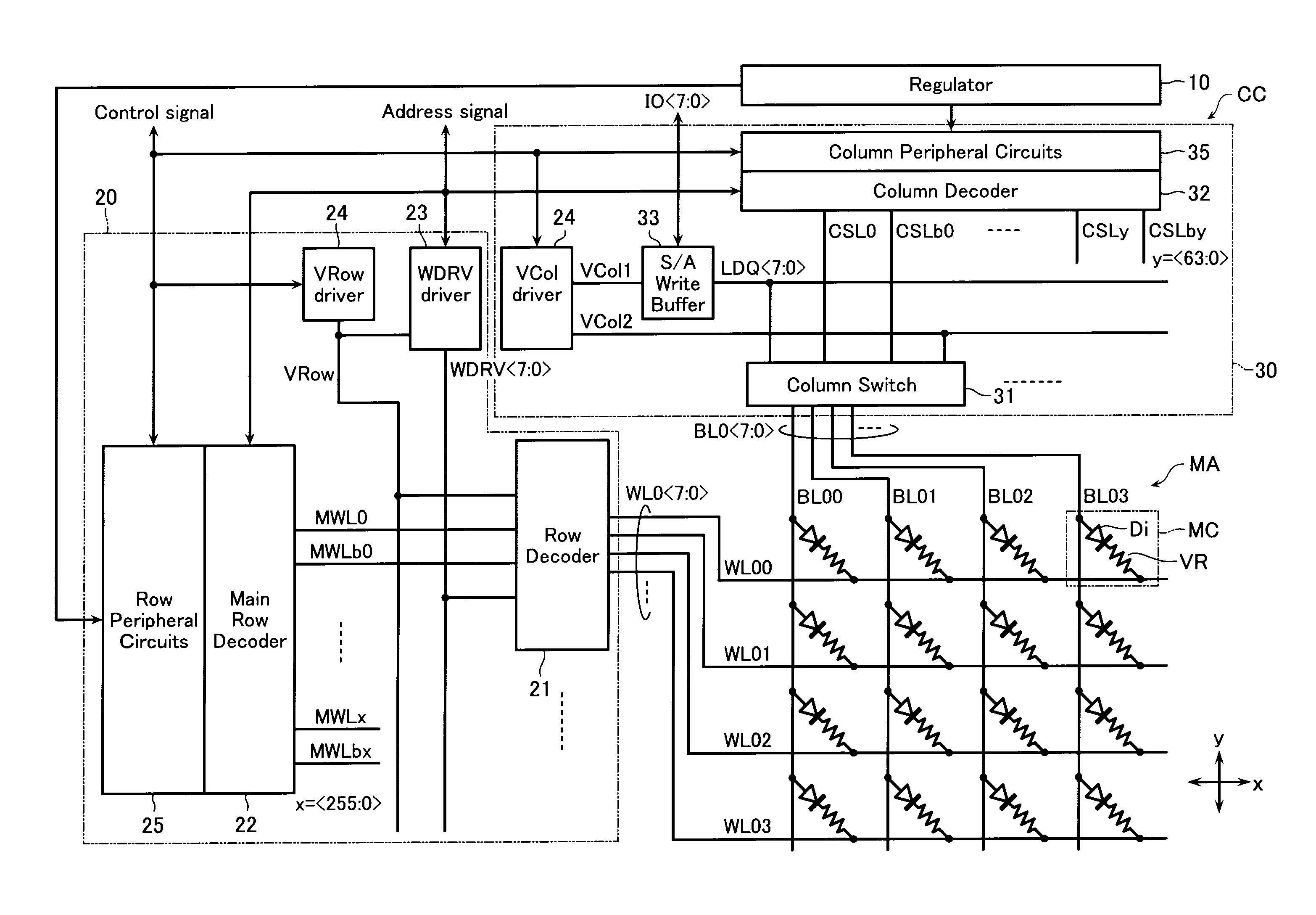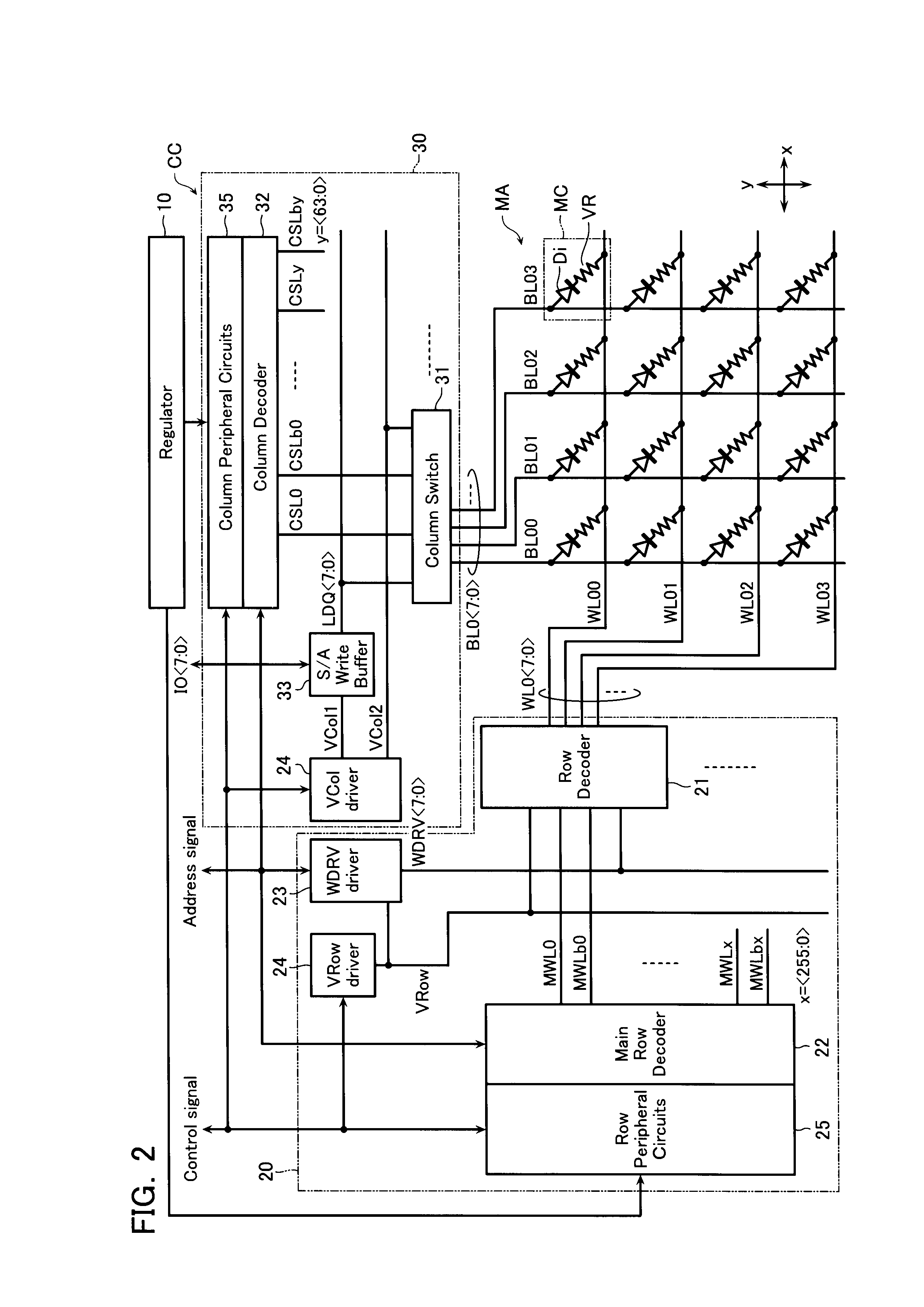Nonvolatile semiconductor memory device and method of resetting the same
a non-volatile semiconductor and memory device technology, applied in the direction of digital storage, static storage, instruments, etc., can solve the problems of higher erroneous setting and higher erroneous setting problem
- Summary
- Abstract
- Description
- Claims
- Application Information
AI Technical Summary
Benefits of technology
Problems solved by technology
Method used
Image
Examples
first embodiment
Schematic Configuration of Nonvolatile Semiconductor Memory Device According to First Embodiment
[0034]FIG. 1 shows a basic configuration of a nonvolatile semiconductor memory device according to a first embodiment of the invention, that is, a configuration of a wiring region 3 in which wires such as a global bus above a semiconductor substrate 1 are formed, and a memory block 2 stacked on the wiring region 3.
[0035]As shown in FIG. 1, in the example, the memory block 2 is made of eight memory cell arrays MA0 to MA7. As will be described later, each memory cell array MA shares a bit line or a word line with other memory cell arrays which are neighboring in a vertical direction. That is, one word line and one bit line are not connected to only a memory cell in one memory cell array but are connected to memory cells in two memory cell arrays which are neighboring in the vertical direction.
[0036]The semiconductor substrate 1 just below the memory block 2 is provided with the wiring regio...
second embodiment
Operation of Nonvolatile Semiconductor Memory Device According to Second Embodiment
[0104]Referring now to FIG. 16, the operation of the nonvolatile semiconductor memory device according to a second embodiment will be described. FIG. 16 is a timing chart showing a resetting operation of the nonvolatile semiconductor memory device according to the second embodiment. Only the resetting operation in the nonvolatile semiconductor memory device according to the second embodiment is different from that of the first embodiment. In the second embodiment, the same reference numerals are designated to components similar to those of the first embodiment and their description will not be repeated.
[0105]First, as shown in FIG. 16, at time t21, the control circuit CC changes the voltage of the selected bit line BL to a shape having “m” steps (m is an integer) and increases it to the voltage VRESET_pre. Next, at time t22, the control circuit CC changes the voltage of the selected bit line BL to a s...
third embodiment
Operation of Nonvolatile Semiconductor Memory Device According to Third Embodiment
[0110]Referring now to FIG. 17, the operation of the nonvolatile semiconductor memory device according to a third embodiment will be described. FIG. 17 is a timing chart showing a resetting operation of the nonvolatile semiconductor memory device according to the third embodiment. Only the resetting operation in the nonvolatile semiconductor memory device according to the third embodiment is different from that of each of the first and second embodiments. In the third embodiment, the same reference numerals are designated to components similar to those of the first and second embodiments and their description will not be repeated.
[0111]First, as shown in FIG. 17, at time t31, the control circuit CC increases the pulse voltage to be applied to the selected bit line BL1 to the voltage VRESET_pre. Next, at time t32, the control circuit CC changes the voltage of the selected bit line BL1 in a comb-teeth-sh...
PUM
 Login to View More
Login to View More Abstract
Description
Claims
Application Information
 Login to View More
Login to View More - R&D
- Intellectual Property
- Life Sciences
- Materials
- Tech Scout
- Unparalleled Data Quality
- Higher Quality Content
- 60% Fewer Hallucinations
Browse by: Latest US Patents, China's latest patents, Technical Efficacy Thesaurus, Application Domain, Technology Topic, Popular Technical Reports.
© 2025 PatSnap. All rights reserved.Legal|Privacy policy|Modern Slavery Act Transparency Statement|Sitemap|About US| Contact US: help@patsnap.com



